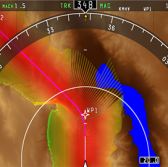 NASA and Rockwell Collins have conducted a usability test and a pilot working group meeting that showcased a sonic boom display at the space agency’s Armstrong Flight Research Center.
NASA and Rockwell Collins have conducted a usability test and a pilot working group meeting that showcased a sonic boom display at the space agency’s Armstrong Flight Research Center.
Rockwell Collins said Wednesday the two-year Sonic Boom Display project resulted in the creation of an impact visualization system designed to help pilots reduce or mitigate the risk of sonic boom impacts during flights.
The team used a NASA-developed cockpit interactive sonic boom display avionics algorithm and a worldwide terrain database in efforts to predict the sonic boom’s impact location on the ground.
“We have collaborated with avionics companies like Rockwell Collins to translate our NASA algorithms into an integrated avionics system that is tested and evaluated by pilots,” said Brett Pauer, manager of commercial supersonic technology subproject at Armstrong Flight Research Center.
John Borghese, vice president of Rockwell Collins’ advanced technology center, said the company seeks to help address noise concerns related to supersonic travel with the sonic boom display system.
The company also plans to integrate a flight planning and guidance application, noise reduction standards and data from the ARINCDirect weather services platform into the project.




